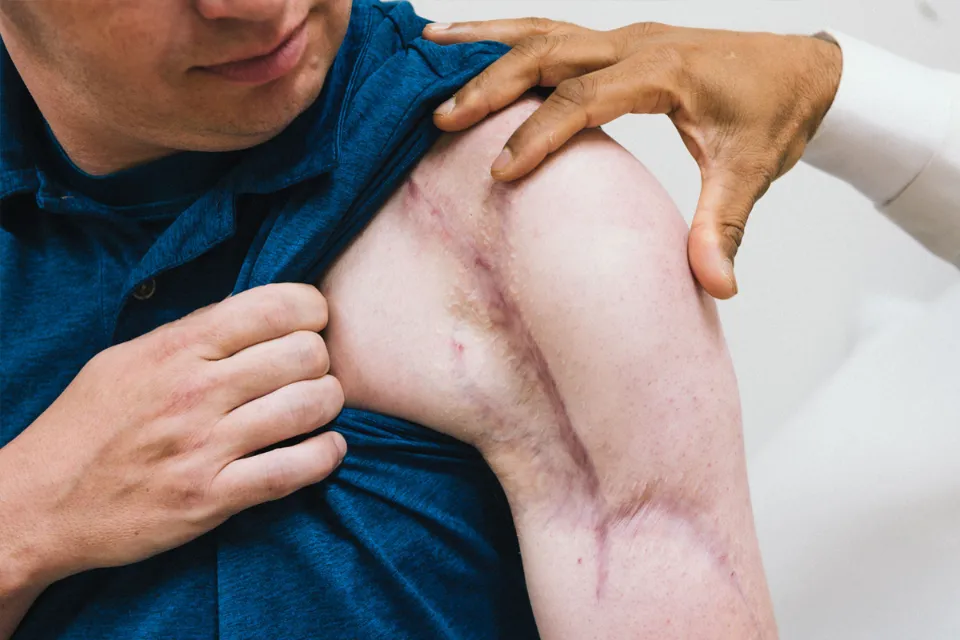Three bones make up your shoulder: the humerus, the scapula, and the clavicle, which is the bone that forms the collarbone. The ball of your upper arm bone, or its head, fits into a small socket in your shoulder blade, forming the shoulder. The term “glenoid” refers to this socket.
Total shoulder replacement is a highly effective procedure to lessen pain and restore mobility in patients with end-stage shoulder arthritis and, in some cases, after a severe shoulder fracture. Surgery to replace the shoulder helps the shoulder regain motion, strength, and function while also reducing pain.
Click here to learn more.
What is Shoulder Replacement?
A complicated procedure called a total shoulder replacement involves using artificial components to replace the shoulder joint. At Johns Hopkins, our shoulder specialists have replaced many shoulders and value the chance to impart their knowledge. They have responded to some of the most typical inquiries regarding the total shoulder replacement procedure. If you have any additional inquiries about shoulder replacement, call us to schedule a consultation with one of our shoulder surgeons.
For pain brought on by arthritis or when the shoulder is severely fractured or broken, a shoulder replacement or artificial shoulder can be used. In cases of arthritis, the ends of the bones rub against one another in the joint because the cartilage has worn away. Fractures, rheumatoid arthritis, rotator cuff tendons that have been torn, as well as general wear and tear over time, are all possible causes of arthritis.

Why Do You Need Shoulder Replacement?
There are a number of ailments that can make shoulders sore and incapacitated that patients consider having their shoulder joints replaced surgically.
Osteoarthritis (Degenerative Joint Disease)
An arthritis caused by wear and tear with aging is called osteoarthritis. Although it can happen to younger people as well, it typically affects people over the age of 50. The cartilage that protects the shoulder’s bones deteriorates and softens over time. Then the bones start to rub against each other. The shoulder joint gradually stiffens and hurts over time.
Osteoarthritis cannot, regrettably, be stopped from occurring. It is a frequent justification for shoulder replacement surgery.
Shoulder osteoarthritis. Painful bone spurs can develop as a result of bone rubbing against bone and the loss of cartilage that covers the ends of the bones.
Severe Fractures
An additional frequent justification for shoulder replacement is a severe shoulder fracture. It might be very challenging for a doctor to reposition the broken pieces of bone when the upper arm bone’s head is broken. Also possible is a disruption in the blood flow to the bone fragments. An operation on the shoulder might be advised in this situation. Severe shoulder fractures are most common in elderly osteoporosis patients.
Post-traumatic Arthritis
When a shoulder injury is severe, this may happen. Over time, articular cartilage may become damaged as a result of shoulder fractures or tears in the shoulder’s tendons or ligaments. As a result, shoulder function is restricted and shoulder pain results.
Rotator Cuff Tear Arthropathy
A patient may experience cuff tear arthropathy if they have a severe, protracted rotator cuff tear. As a result of the rotator cuff tear, the shoulder joint may undergo changes that can result in arthritis and cartilage loss.
Rheumatoid Arthritis
In this condition, the synovial membrane that covers the joint thickens and becomes inflamed. Chronic inflammation can harm cartilage, leading to eventual cartilage loss, discomfort, and stiffness. The most prevalent form of the group of diseases known as inflammatory arthritis is rheumatoid arthritis.
Avascular Necrosis (Osteonecrosis)
When the blood supply to the bone is compromised, avascular necrosis, also known as osteonecrosis, is a painful condition that develops. Osteonecrosis can eventually destroy the shoulder joint and result in arthritis because bone cells cannot survive without a blood supply. Avascular necrosis is a condition that can be brought on by chronic steroid use, deep sea diving, severe shoulder fractures, sickle cell disease, and heavy alcohol consumption.
Shoulder Replacement Types
Total Shoulder Replacement
The typical total shoulder replacement involves inserting a highly polished metal ball on a stem and a plastic socket to replace the worn-out joint surfaces.
Different sizes of these parts are available. They can either be press fitted or cemented into the bone. Your surgeon might decide to use a non-cemented (press-fit) humeral component if the bone is in good condition. If the bone is soft, bone cement may be used to implant the humeral component. Bone cement is typically used to implant an all-plastic glenoid (socket) component.
Implantation of a glenoid component is not advised if:
- The glenoid has good cartilage
- The glenoid bone is severely deficient
- The rotator cuff tendons are irreparably torn
Conventional total shoulder replacement is generally a good option for patients with bone-on-bone osteoarthritis and healthy rotator cuff tendons.
Reverse Total Shoulder Replacement
Reverse total shoulder replacement is a different kind of replacement for the shoulders. Reverse total shoulder replacement is used for people who have:
- Completely torn rotator cuffs with severe arm weakness
- The effects of severe arthritis and rotator cuff tearing (cuff tear arthropathy)
- Had a previous shoulder replacement that failed
For those people, a traditional total shoulder replacement may still cause pain. Additionally, they might be unable to raise their arm higher than a 90-degree angle. It can be very crippling to be unable to lift your arm away from the side.
In a reverse total shoulder replacement, the socket and metal ball are switched: a metal ball is attached to the shoulder bone, and a plastic socket is attached to the upper arm bone. This enables the patient to lift the arm without using the torn rotator cuff and instead use the deltoid muscle.
Stemmed Hemiarthroplasty
Your doctor might decide to only replace the ball, depending on the state of your shoulder. Hemiarthroplasty refers to this procedure. A metal ball and stem, similar to the part used in a total shoulder replacement, are used by the surgeon in a traditional hemiarthroplasty to replace the humerus’ head. A stemmed hemiarthroplasty is what this is known as.
Even though the socket is normal, some surgeons advise hemiarthroplasty when the humeral head is severely fractured. Other indications for a hemiarthroplasty include:
- Arthritis that involves only the head of the humerus, with a glenoid that has a healthy and intact cartilage surface
- Shoulders with severely weakened bone in the glenoid
- Some shoulders with severely torn rotator cuff tendons and arthritis
At the time of surgery, doctors will occasionally choose between a hemiarthroplasty and a total shoulder replacement.
Studies have shown that total shoulder arthroplasty offers osteoarthritis patients more pain relief than hemiarthroplasty does.
Resurfacing Hemiarthroplasty
A cap-like prosthesis without a stem is used in resurfacing hemiarthroplasty to replace only the joint surface of the humeral head. With its bone-preserving benefit, it provides those with shoulder arthritis with an alternative to the conventional stemmed shoulder replacement.
Resurfacing hemiarthroplasty may be an option for you if:
- The glenoid still has an intact cartilage surface
- There has been no fresh fracture of the humeral neck or head
- There is a desire to preserve humeral bone
Resurfacing hemiarthroplasty for patients who are young or very active reduces the risks of component wear and loosening that may happen with conventional total shoulder replacements in this patient population. Resurfacing hemiarthroplasty may be simpler to convert to a total shoulder replacement in the future, if necessary, due to its more conservative nature.

What Can You Expect from Shoulder Replacement Surgery?
Pain relief from shoulder replacement surgery is excellent. The majority of patients are very pleased with the level of pain relief. These shoulder replacements aren’t flawless, though, and you might experience a little discomfort if the weather changes or if you overdo it with activity.
Despite the fact that the amount of improvement is less predictable than pain relief, this surgery can increase range of motion and function. The amount of increased motion is dependent on a variety of factors, including the length of time the motion has been lost and the health and function of the rotator cuff tendons.
The majority of patients are extremely happy with the outcomes of their surgery.
What Are the Alternative Options to Shoulder Replacement?
A shoulder arthroscopy procedure is frequently recommended people who have shoulder conditions that involve the surrounding ligaments, muscles and tendons, such as a:
- Rotator cuff injury
- Torn shoulder labrum
Because it requires little to no incision, arthroscopy is one of the most popular types of shoulder surgeries. However, arthroscopic surgery primarily treats conditions that cause arthritis, rather than the arthritis itself. Patients who do not yet have bone-on-bone arthritis typically benefit from this therapy.
Are There Risks and Complications of a Shoulder Replacement?
Complications are rare in total shoulder replacement, but can include:
- Instability (the ball slipping out of the socket)
- Infection
- Nerve damage
- Glenoid loosening
- Stiffness*
*Prior to surgery, an arthritic shoulder is frequently extremely tense. However, if stiffness in a shoulder persists even after motion was restored during surgery, this is typically due to insufficient rehabilitation. Restoring shoulder motion and strength typically requires ongoing physical therapy.
Conclusion
Newer, better shoulder replacements that can be installed using less invasive surgical methods are currently being designed and developed. To find out which patients make the best candidates for which kind of shoulder replacement surgery, researchers are also gathering data. With this knowledge, your surgeon will be able to give you the best advice for treating your arthritic shoulder.



